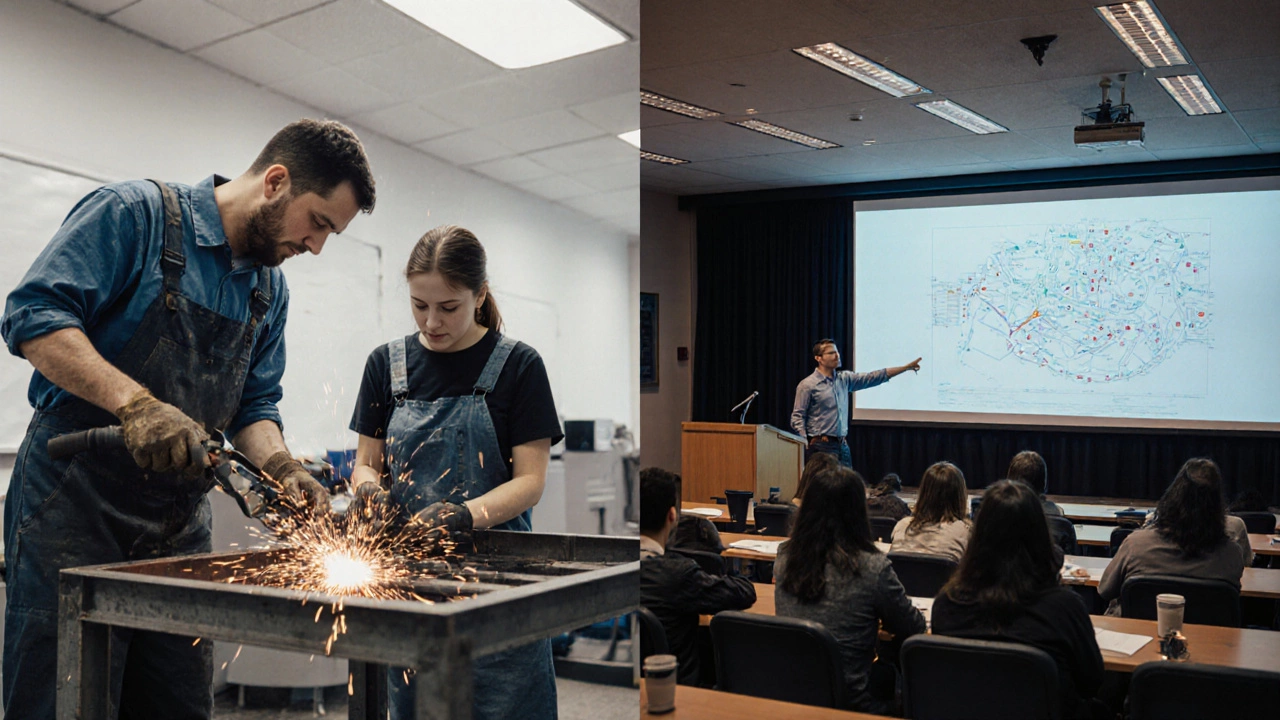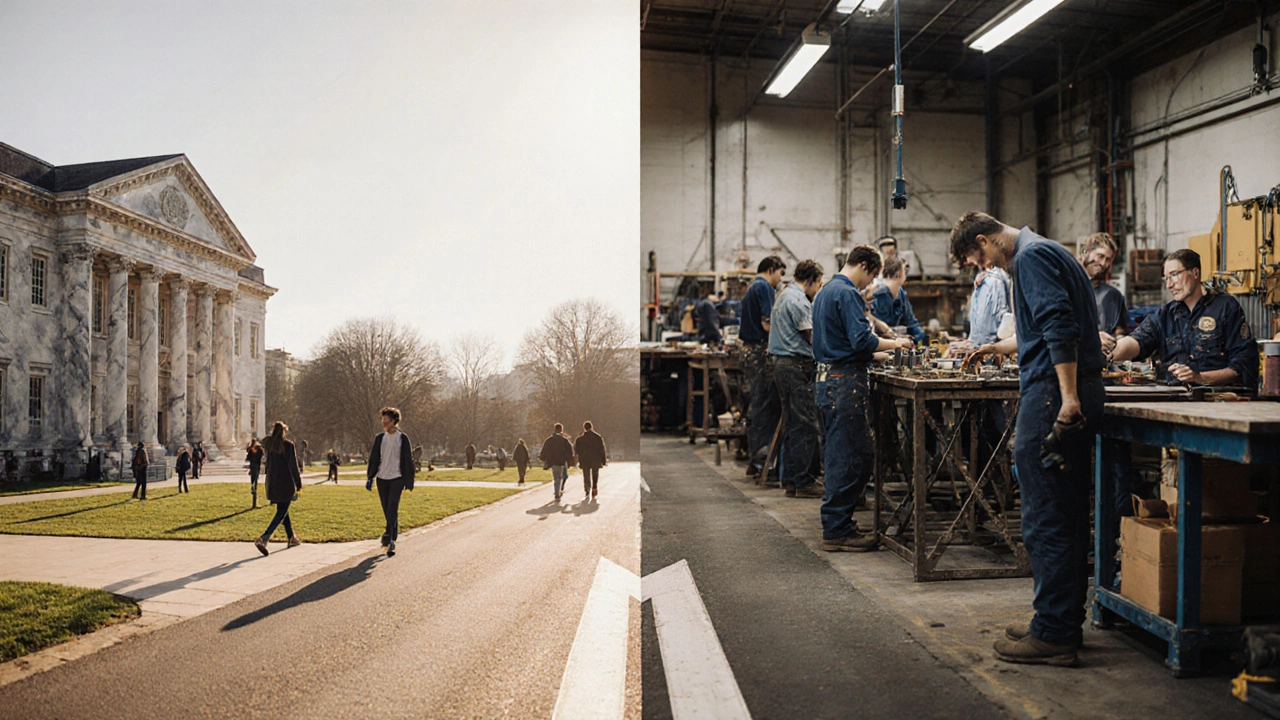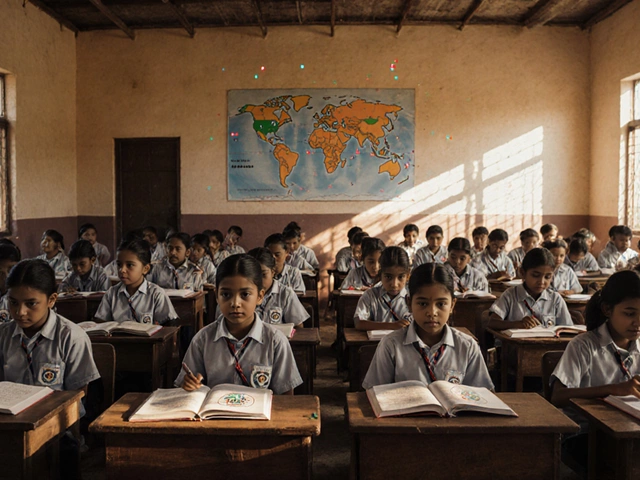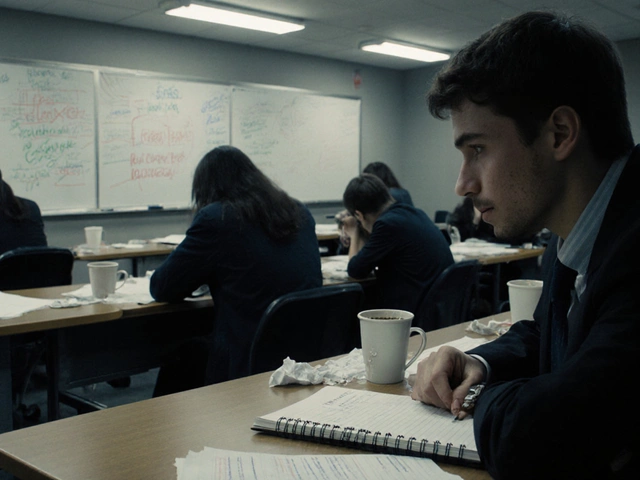Ever wondered why some people head straight to a trade shop while others enroll in a university? The answer lies in the fundamental split between vocational education and academic education. Understanding this split helps you pick the right path, avoid costly detours, and line up your goals with the right kind of learning.
Quick Takeaways
- Vocational education focuses on job‑ready skills, often finished in 1‑2 years.
- Academic education prepares for broader knowledge and usually requires 3‑4 years for a bachelor’s degree.
- Trade schools and apprenticeships are the main delivery models for vocational learning.
- Career pathways differ: vocational routes lead straight to specific occupations, while academic routes open doors to multiple fields.
- Cost, duration, and credential type are the three major decision factors.
What Exactly Is Vocational Education?
Vocational education is a type of learning that equips students with practical skills directly tied to a specific trade or occupation. It often blends classroom instruction with hands‑on training, and the end goal is a credential that proves competence on the job.
Typical formats include:
- Certificate programs that last a few months to two years.
- Apprenticeships where learners earn while they learn, spending most of their time on‑the‑job.
- Technical diplomas offered at community colleges or dedicated trade schools.
Because the curriculum mirrors real‑world tasks, employers value vocational graduates for their ability to hit the ground running.
What Is Academic Education?
Academic education refers to the traditional school‑based learning found in primary, secondary, and higher‑education institutions. Its emphasis is on theory, critical thinking, and a broad knowledge base that can be applied across many domains.
Key features:
- Degrees (associate, bachelor, master, doctorate) are the primary credentials.
- Courses cover subjects like mathematics, humanities, sciences, and social studies.
- Learning often includes lectures, labs, research projects, and exams.
Graduates are equipped for a range of careers, further study, or roles that demand analytical and problem‑solving abilities.
Side‑by‑Side Comparison
| Attribute | Vocational Education | Academic Education |
|---|---|---|
| Primary Goal | Job‑ready skills for a specific trade | Broad knowledge and critical thinking |
| Typical Duration | 6 months - 2 years (certificate/diploma) | 3-4 years for a bachelor's degree; longer for advanced degrees |
| Credential | Certificate, diploma, apprenticeship completion | Associate, bachelor, master, doctorate |
| Learning Style | Hands‑on labs, workshops, on‑the‑job training | Lectures, readings, research papers, exams |
| Entry Requirements | High school diploma or equivalent; often open‑entry | High school diploma + standardized test scores (SAT/ACT, etc.) |
| Typical Salary (US, 2024) | $35,000 - $55,000 for entry‑level trades | $55,000 - $80,000 for bachelor‑level graduates (varies by field) |
| Career Pathway | Direct entry into specific occupations (e.g., electrician, dental hygienist) | Broad options; may require further specialization or certification |

Key Decision Factors
Choosing between the two isn’t a matter of “better” - it’s about fit. Below are the three biggest levers you’ll weigh.
- Cost and Return on Investment: Vocational programs often cost less than a four‑year degree. According to the National Center for Education Statistics, average tuition for a two‑year community college program was $3,800 in 2024, while a public four‑year university averaged $10,200 per year. Factor in potential earnings within the first year after graduation.
- Time to Workforce: If you need to start earning quickly, vocational tracks can get you job‑ready in under two years. Academic routes generally require longer study periods before entering the job market.
- Career Goals: Some professions (e.g., engineering, medicine, law) legally require degrees. Others (e.g., HVAC technician, culinary arts) rely on certifications and apprenticeships.
Real‑World Scenarios
Apprenticeship in plumbing illustrates the vocational path. Maria started a 1‑year apprenticeship after high school. She earned a wage while learning, gained a journeyman license, and now earns $58,000 a year without student loan debt.
Contrast that with Alex, who pursued a bachelor's in computer science. He spent four years in college, took out $30,000 in loans, and now works as a software developer earning $95,000. Both routes worked for them, but the timelines and financial commitments differed dramatically.
Common Misconceptions
- “Vocational means low‑skill.” Modern vocational programs cover high‑tech fields like CNC machining, cybersecurity, and medical imaging-areas that require deep technical knowledge.
- “Academic education guarantees a job.” A degree opens doors, but without internships, networking, and practical experience, graduates may still face a tough job market.
- “You can’t switch later.” Many vocational learners later pursue associate or bachelor degrees, and many academic graduates add certifications to specialize.

How to Blend Both Paths
If you’re undecided, consider a hybrid strategy. Start with a vocational certificate in a high‑growth trade (e.g., renewable‑energy technician). After gaining work experience, you can enroll in a part‑time associate degree to broaden your credentials. This stacking approach maximizes earnings while keeping education flexible.
Choosing the Right Option for You
Ask yourself these quick questions:
- Do I need a specific credential to enter my desired field?
- How much time can I invest before I need a steady income?
- What’s my budget for tuition and living expenses?
- Am I comfortable with on‑the‑job training, or do I prefer a classroom environment?
Your answers will point you toward either a vocational program, an academic degree, or a combination of both.
Frequently Asked Questions
Is vocational education only for low‑income students?
No. Vocational programs attract a wide range of learners, including adults seeking career changes, high school graduates aiming for fast entry into skilled trades, and even professionals upgrading to newer technologies. The key draw is the focus on job‑ready skills, not income level.
Can I earn a bachelor's degree after completing a vocational certificate?
Yes. Many community colleges and universities accept vocational credits toward associate or bachelor degrees, especially in fields like engineering technology, health services, and information technology. Credit‑transfer policies vary, so check with the institution.
Which path offers higher lifetime earnings?
On average, bachelor‑degree holders earn more over a lifetime than those with only a vocational certificate, according to the U.S. Bureau of Labor Statistics. However, many trades-such as electricians, plumbers, and specialized IT technicians-can achieve six‑figure salaries with experience, certifications, and business ownership.
Do employers value academic degrees more than certifications?
It depends on the industry. In fields like medicine, law, and academia, degrees are mandatory. In tech, manufacturing, and skilled trades, certifications often carry more weight because they prove current, hands‑on competence.
What are the most in‑demand vocational fields in 2025?
According to the World Economic Forum, the fastest‑growing vocational sectors include renewable‑energy technicians, advanced manufacturing (robotics, CNC machining), cybersecurity analysts, and health‑care support roles like medical assistants and dental hygienists.












